BSBPMG511 - Managing Project Scope: Public Transport Training Program
VerifiedAdded on 2023/06/04
|41
|14205
|154
Project
AI Summary
This project solution addresses the BSBPMG511 assignment, focusing on managing project scope for developing a training program for authorized officers in a metropolitan public transport system (MPTS). The project involves creating a product description development outline, scope statement, scope management plan, and a scope change control system. The training program aims to enhance customer relations, communication skills, and cultural sensitivity among officers. The solution includes templates detailing project justification, deliverables, objectives, cost, schedule, and quality measures. It also outlines how project scope will be managed, including identifying and classifying scope changes, integrating changes into the project, and defining responsibilities for approving scope changes. This project aims to align the training with national standards, meeting stakeholder expectations and legal requirements, while adhering to a budget of $240,000 over 18 months. Desklib provides more solved assignments and study tools for students.
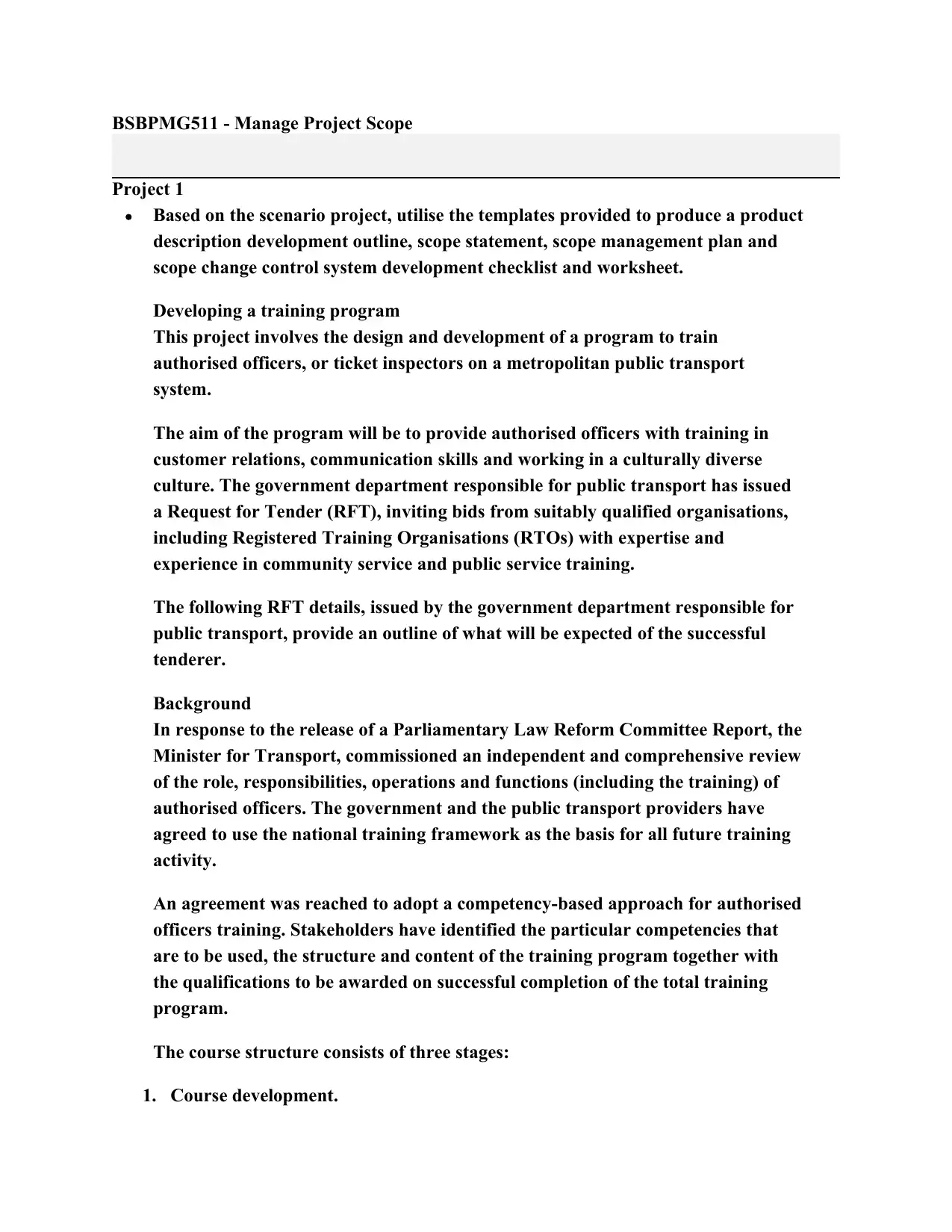
BSBPMG511 - Manage Project Scope
Project 1
Based on the scenario project, utilise the templates provided to produce a product
description development outline, scope statement, scope management plan and
scope change control system development checklist and worksheet.
Developing a training program
This project involves the design and development of a program to train
authorised officers, or ticket inspectors on a metropolitan public transport
system.
The aim of the program will be to provide authorised officers with training in
customer relations, communication skills and working in a culturally diverse
culture. The government department responsible for public transport has issued
a Request for Tender (RFT), inviting bids from suitably qualified organisations,
including Registered Training Organisations (RTOs) with expertise and
experience in community service and public service training.
The following RFT details, issued by the government department responsible for
public transport, provide an outline of what will be expected of the successful
tenderer.
Background
In response to the release of a Parliamentary Law Reform Committee Report, the
Minister for Transport, commissioned an independent and comprehensive review
of the role, responsibilities, operations and functions (including the training) of
authorised officers. The government and the public transport providers have
agreed to use the national training framework as the basis for all future training
activity.
An agreement was reached to adopt a competency-based approach for authorised
officers training. Stakeholders have identified the particular competencies that
are to be used, the structure and content of the training program together with
the qualifications to be awarded on successful completion of the total training
program.
The course structure consists of three stages:
1. Course development.
Project 1
Based on the scenario project, utilise the templates provided to produce a product
description development outline, scope statement, scope management plan and
scope change control system development checklist and worksheet.
Developing a training program
This project involves the design and development of a program to train
authorised officers, or ticket inspectors on a metropolitan public transport
system.
The aim of the program will be to provide authorised officers with training in
customer relations, communication skills and working in a culturally diverse
culture. The government department responsible for public transport has issued
a Request for Tender (RFT), inviting bids from suitably qualified organisations,
including Registered Training Organisations (RTOs) with expertise and
experience in community service and public service training.
The following RFT details, issued by the government department responsible for
public transport, provide an outline of what will be expected of the successful
tenderer.
Background
In response to the release of a Parliamentary Law Reform Committee Report, the
Minister for Transport, commissioned an independent and comprehensive review
of the role, responsibilities, operations and functions (including the training) of
authorised officers. The government and the public transport providers have
agreed to use the national training framework as the basis for all future training
activity.
An agreement was reached to adopt a competency-based approach for authorised
officers training. Stakeholders have identified the particular competencies that
are to be used, the structure and content of the training program together with
the qualifications to be awarded on successful completion of the total training
program.
The course structure consists of three stages:
1. Course development.
Paraphrase This Document
Need a fresh take? Get an instant paraphrase of this document with our AI Paraphraser
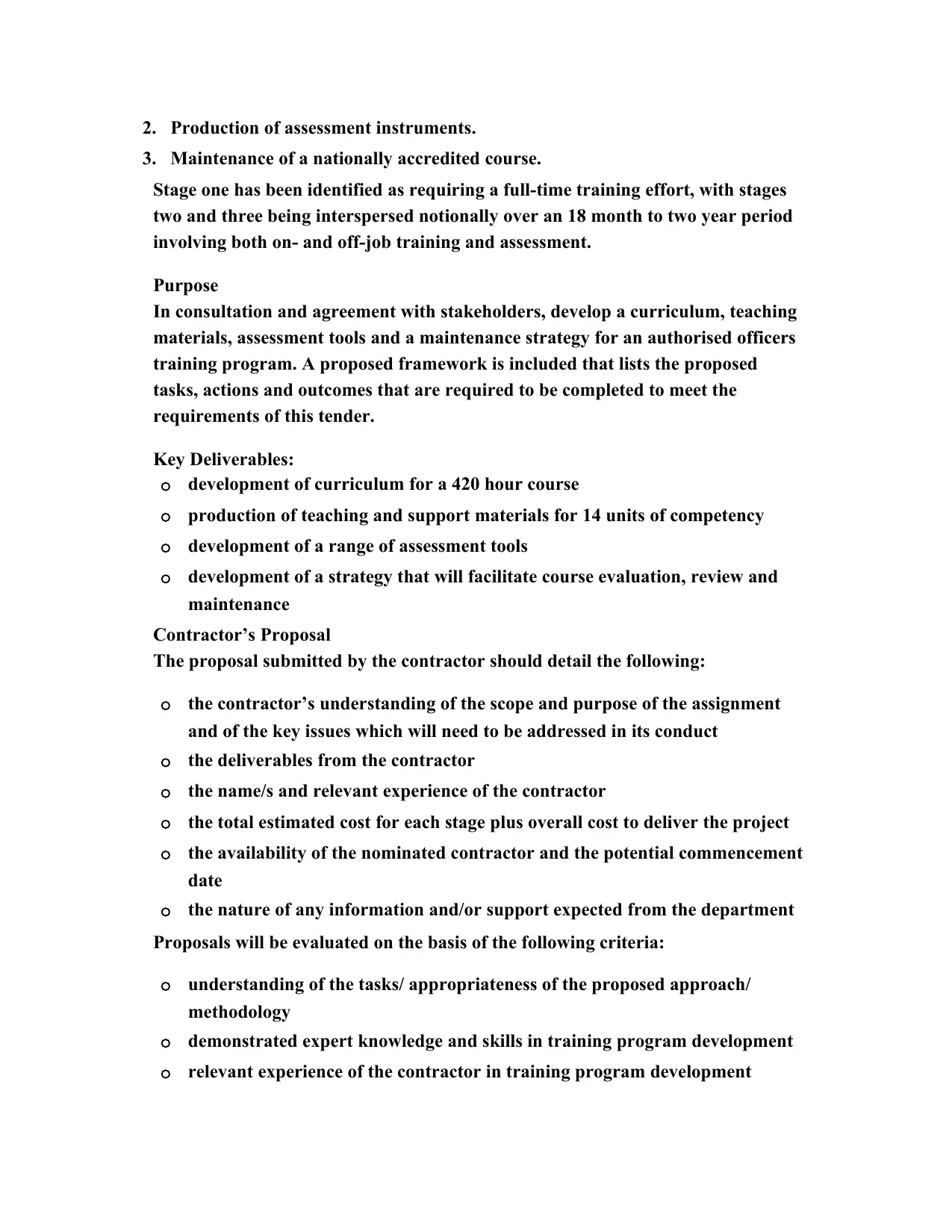
2. Production of assessment instruments.
3. Maintenance of a nationally accredited course.
Stage one has been identified as requiring a full-time training effort, with stages
two and three being interspersed notionally over an 18 month to two year period
involving both on- and off-job training and assessment.
Purpose
In consultation and agreement with stakeholders, develop a curriculum, teaching
materials, assessment tools and a maintenance strategy for an authorised officers
training program. A proposed framework is included that lists the proposed
tasks, actions and outcomes that are required to be completed to meet the
requirements of this tender.
Key Deliverables:
o development of curriculum for a 420 hour course
o production of teaching and support materials for 14 units of competency
o development of a range of assessment tools
o development of a strategy that will facilitate course evaluation, review and
maintenance
Contractor’s Proposal
The proposal submitted by the contractor should detail the following:
o the contractor’s understanding of the scope and purpose of the assignment
and of the key issues which will need to be addressed in its conduct
o the deliverables from the contractor
o the name/s and relevant experience of the contractor
o the total estimated cost for each stage plus overall cost to deliver the project
o the availability of the nominated contractor and the potential commencement
date
o the nature of any information and/or support expected from the department
Proposals will be evaluated on the basis of the following criteria:
o understanding of the tasks/ appropriateness of the proposed approach/
methodology
o demonstrated expert knowledge and skills in training program development
o relevant experience of the contractor in training program development
3. Maintenance of a nationally accredited course.
Stage one has been identified as requiring a full-time training effort, with stages
two and three being interspersed notionally over an 18 month to two year period
involving both on- and off-job training and assessment.
Purpose
In consultation and agreement with stakeholders, develop a curriculum, teaching
materials, assessment tools and a maintenance strategy for an authorised officers
training program. A proposed framework is included that lists the proposed
tasks, actions and outcomes that are required to be completed to meet the
requirements of this tender.
Key Deliverables:
o development of curriculum for a 420 hour course
o production of teaching and support materials for 14 units of competency
o development of a range of assessment tools
o development of a strategy that will facilitate course evaluation, review and
maintenance
Contractor’s Proposal
The proposal submitted by the contractor should detail the following:
o the contractor’s understanding of the scope and purpose of the assignment
and of the key issues which will need to be addressed in its conduct
o the deliverables from the contractor
o the name/s and relevant experience of the contractor
o the total estimated cost for each stage plus overall cost to deliver the project
o the availability of the nominated contractor and the potential commencement
date
o the nature of any information and/or support expected from the department
Proposals will be evaluated on the basis of the following criteria:
o understanding of the tasks/ appropriateness of the proposed approach/
methodology
o demonstrated expert knowledge and skills in training program development
o relevant experience of the contractor in training program development
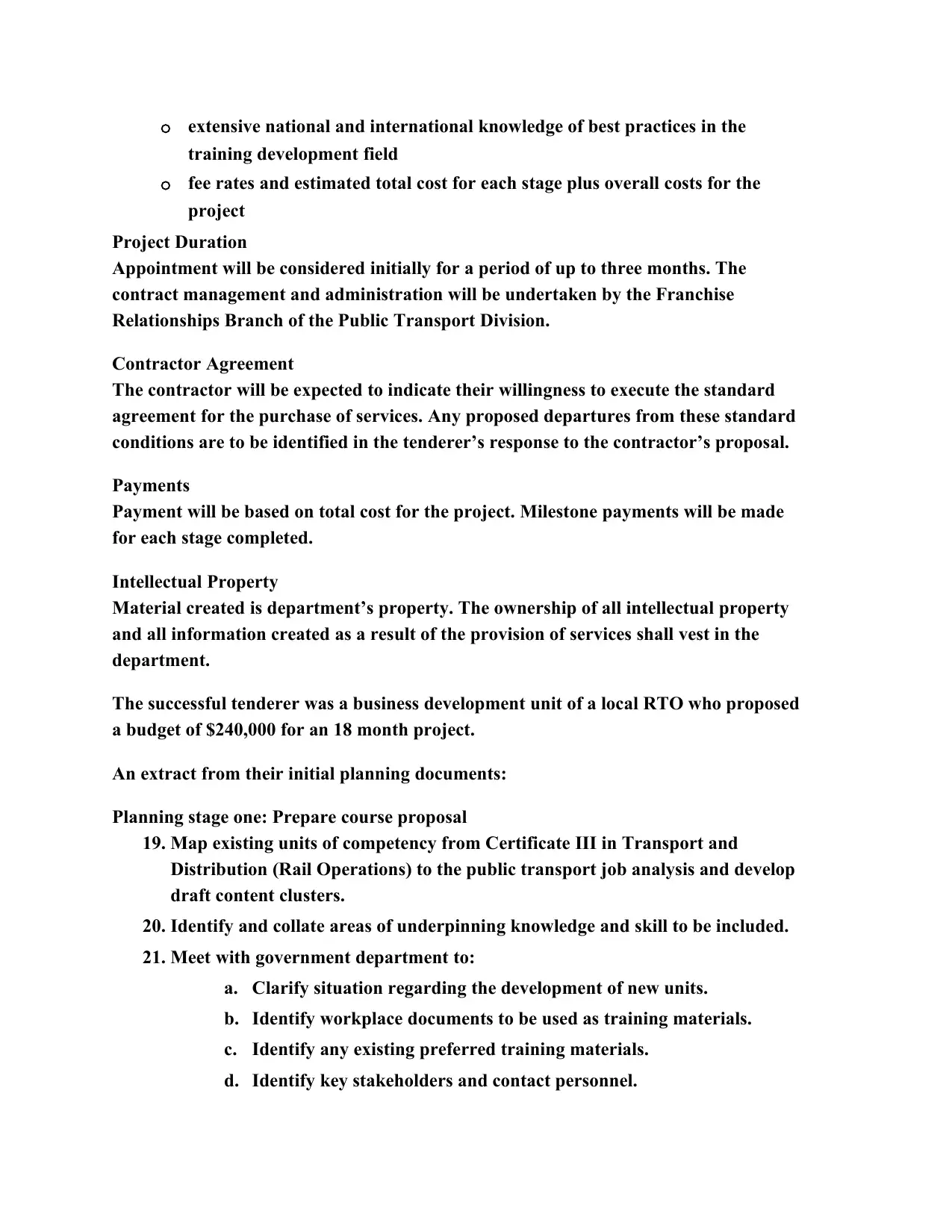
o extensive national and international knowledge of best practices in the
training development field
o fee rates and estimated total cost for each stage plus overall costs for the
project
Project Duration
Appointment will be considered initially for a period of up to three months. The
contract management and administration will be undertaken by the Franchise
Relationships Branch of the Public Transport Division.
Contractor Agreement
The contractor will be expected to indicate their willingness to execute the standard
agreement for the purchase of services. Any proposed departures from these standard
conditions are to be identified in the tenderer’s response to the contractor’s proposal.
Payments
Payment will be based on total cost for the project. Milestone payments will be made
for each stage completed.
Intellectual Property
Material created is department’s property. The ownership of all intellectual property
and all information created as a result of the provision of services shall vest in the
department.
The successful tenderer was a business development unit of a local RTO who proposed
a budget of $240,000 for an 18 month project.
An extract from their initial planning documents:
Planning stage one: Prepare course proposal
19. Map existing units of competency from Certificate III in Transport and
Distribution (Rail Operations) to the public transport job analysis and develop
draft content clusters.
20. Identify and collate areas of underpinning knowledge and skill to be included.
21. Meet with government department to:
a. Clarify situation regarding the development of new units.
b. Identify workplace documents to be used as training materials.
c. Identify any existing preferred training materials.
d. Identify key stakeholders and contact personnel.
training development field
o fee rates and estimated total cost for each stage plus overall costs for the
project
Project Duration
Appointment will be considered initially for a period of up to three months. The
contract management and administration will be undertaken by the Franchise
Relationships Branch of the Public Transport Division.
Contractor Agreement
The contractor will be expected to indicate their willingness to execute the standard
agreement for the purchase of services. Any proposed departures from these standard
conditions are to be identified in the tenderer’s response to the contractor’s proposal.
Payments
Payment will be based on total cost for the project. Milestone payments will be made
for each stage completed.
Intellectual Property
Material created is department’s property. The ownership of all intellectual property
and all information created as a result of the provision of services shall vest in the
department.
The successful tenderer was a business development unit of a local RTO who proposed
a budget of $240,000 for an 18 month project.
An extract from their initial planning documents:
Planning stage one: Prepare course proposal
19. Map existing units of competency from Certificate III in Transport and
Distribution (Rail Operations) to the public transport job analysis and develop
draft content clusters.
20. Identify and collate areas of underpinning knowledge and skill to be included.
21. Meet with government department to:
a. Clarify situation regarding the development of new units.
b. Identify workplace documents to be used as training materials.
c. Identify any existing preferred training materials.
d. Identify key stakeholders and contact personnel.
⊘ This is a preview!⊘
Do you want full access?
Subscribe today to unlock all pages.

Trusted by 1+ million students worldwide
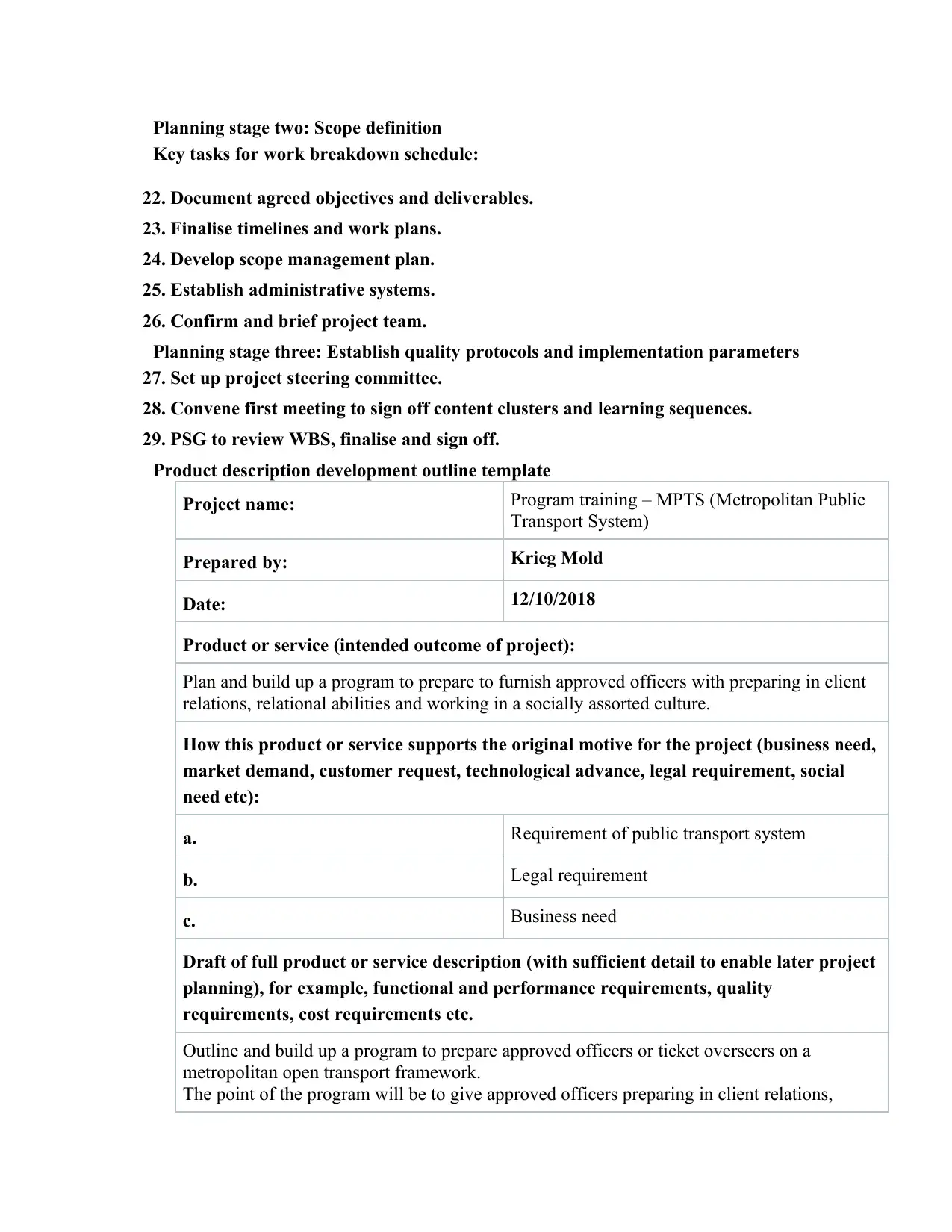
Planning stage two: Scope definition
Key tasks for work breakdown schedule:
22. Document agreed objectives and deliverables.
23. Finalise timelines and work plans.
24. Develop scope management plan.
25. Establish administrative systems.
26. Confirm and brief project team.
Planning stage three: Establish quality protocols and implementation parameters
27. Set up project steering committee.
28. Convene first meeting to sign off content clusters and learning sequences.
29. PSG to review WBS, finalise and sign off.
Product description development outline template
Project name: Program training – MPTS (Metropolitan Public
Transport System)
Prepared by: Krieg Mold
Date: 12/10/2018
Product or service (intended outcome of project):
Plan and build up a program to prepare to furnish approved officers with preparing in client
relations, relational abilities and working in a socially assorted culture.
How this product or service supports the original motive for the project (business need,
market demand, customer request, technological advance, legal requirement, social
need etc):
a. Requirement of public transport system
b. Legal requirement
c. Business need
Draft of full product or service description (with sufficient detail to enable later project
planning), for example, functional and performance requirements, quality
requirements, cost requirements etc.
Outline and build up a program to prepare approved officers or ticket overseers on a
metropolitan open transport framework.
The point of the program will be to give approved officers preparing in client relations,
Key tasks for work breakdown schedule:
22. Document agreed objectives and deliverables.
23. Finalise timelines and work plans.
24. Develop scope management plan.
25. Establish administrative systems.
26. Confirm and brief project team.
Planning stage three: Establish quality protocols and implementation parameters
27. Set up project steering committee.
28. Convene first meeting to sign off content clusters and learning sequences.
29. PSG to review WBS, finalise and sign off.
Product description development outline template
Project name: Program training – MPTS (Metropolitan Public
Transport System)
Prepared by: Krieg Mold
Date: 12/10/2018
Product or service (intended outcome of project):
Plan and build up a program to prepare to furnish approved officers with preparing in client
relations, relational abilities and working in a socially assorted culture.
How this product or service supports the original motive for the project (business need,
market demand, customer request, technological advance, legal requirement, social
need etc):
a. Requirement of public transport system
b. Legal requirement
c. Business need
Draft of full product or service description (with sufficient detail to enable later project
planning), for example, functional and performance requirements, quality
requirements, cost requirements etc.
Outline and build up a program to prepare approved officers or ticket overseers on a
metropolitan open transport framework.
The point of the program will be to give approved officers preparing in client relations,
Paraphrase This Document
Need a fresh take? Get an instant paraphrase of this document with our AI Paraphraser
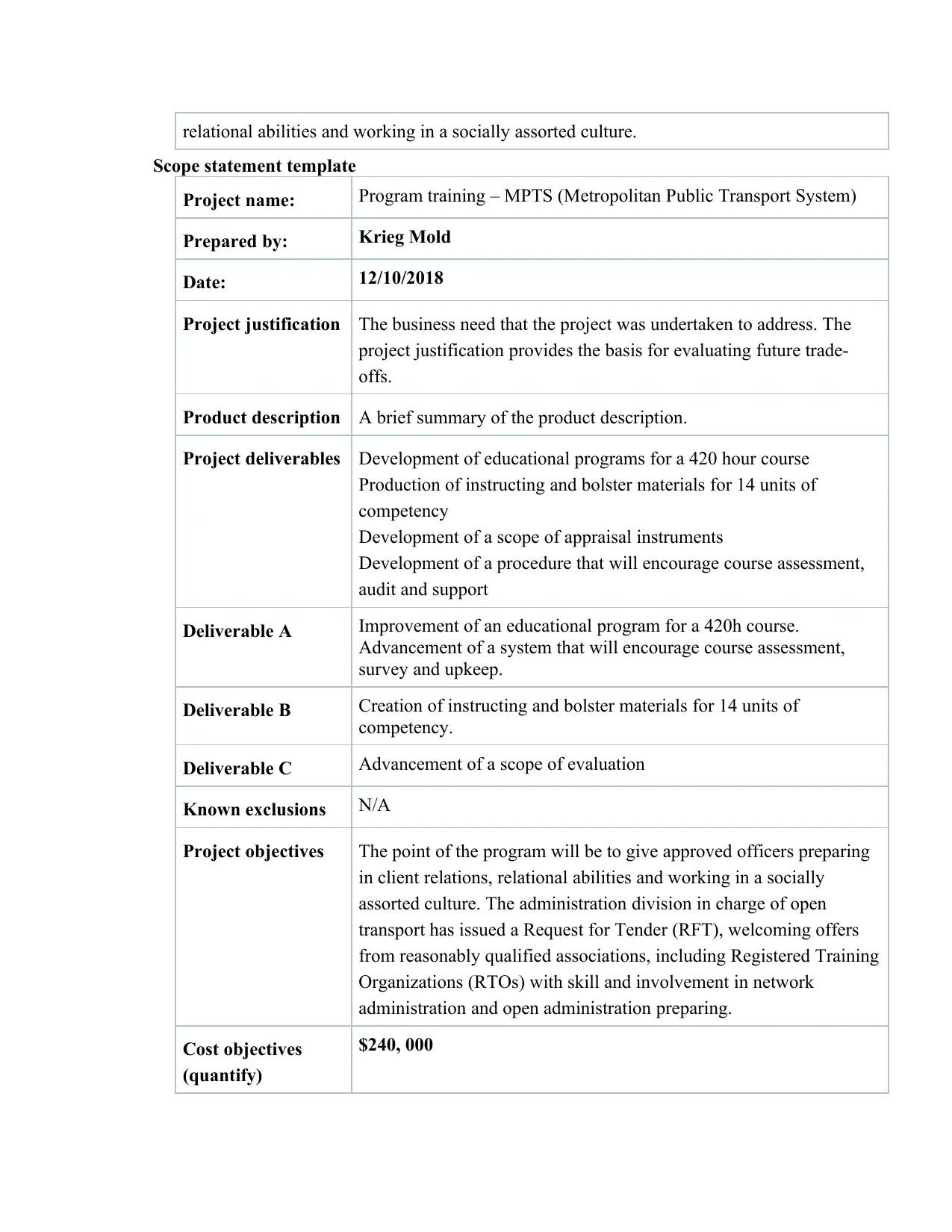
relational abilities and working in a socially assorted culture.
Scope statement template
Project name: Program training – MPTS (Metropolitan Public Transport System)
Prepared by: Krieg Mold
Date: 12/10/2018
Project justification The business need that the project was undertaken to address. The
project justification provides the basis for evaluating future trade-
offs.
Product description A brief summary of the product description.
Project deliverables Development of educational programs for a 420 hour course
Production of instructing and bolster materials for 14 units of
competency
Development of a scope of appraisal instruments
Development of a procedure that will encourage course assessment,
audit and support
Deliverable A Improvement of an educational program for a 420h course.
Advancement of a system that will encourage course assessment,
survey and upkeep.
Deliverable B Creation of instructing and bolster materials for 14 units of
competency.
Deliverable C Advancement of a scope of evaluation
Known exclusions N/A
Project objectives The point of the program will be to give approved officers preparing
in client relations, relational abilities and working in a socially
assorted culture. The administration division in charge of open
transport has issued a Request for Tender (RFT), welcoming offers
from reasonably qualified associations, including Registered Training
Organizations (RTOs) with skill and involvement in network
administration and open administration preparing.
Cost objectives
(quantify)
$240, 000
Scope statement template
Project name: Program training – MPTS (Metropolitan Public Transport System)
Prepared by: Krieg Mold
Date: 12/10/2018
Project justification The business need that the project was undertaken to address. The
project justification provides the basis for evaluating future trade-
offs.
Product description A brief summary of the product description.
Project deliverables Development of educational programs for a 420 hour course
Production of instructing and bolster materials for 14 units of
competency
Development of a scope of appraisal instruments
Development of a procedure that will encourage course assessment,
audit and support
Deliverable A Improvement of an educational program for a 420h course.
Advancement of a system that will encourage course assessment,
survey and upkeep.
Deliverable B Creation of instructing and bolster materials for 14 units of
competency.
Deliverable C Advancement of a scope of evaluation
Known exclusions N/A
Project objectives The point of the program will be to give approved officers preparing
in client relations, relational abilities and working in a socially
assorted culture. The administration division in charge of open
transport has issued a Request for Tender (RFT), welcoming offers
from reasonably qualified associations, including Registered Training
Organizations (RTOs) with skill and involvement in network
administration and open administration preparing.
Cost objectives
(quantify)
$240, 000
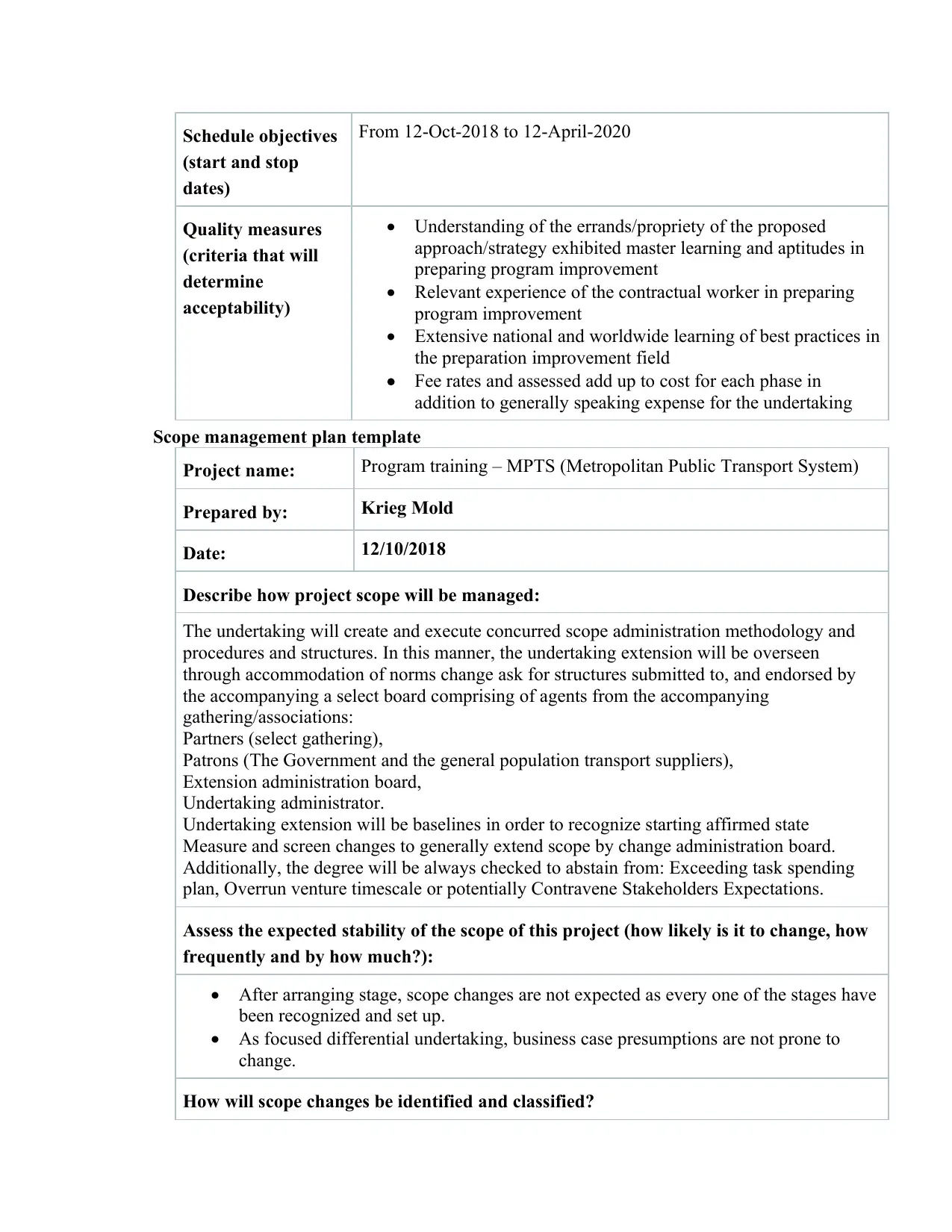
Schedule objectives
(start and stop
dates)
From 12-Oct-2018 to 12-April-2020
Quality measures
(criteria that will
determine
acceptability)
Understanding of the errands/propriety of the proposed
approach/strategy exhibited master learning and aptitudes in
preparing program improvement
Relevant experience of the contractual worker in preparing
program improvement
Extensive national and worldwide learning of best practices in
the preparation improvement field
Fee rates and assessed add up to cost for each phase in
addition to generally speaking expense for the undertaking
Scope management plan template
Project name: Program training – MPTS (Metropolitan Public Transport System)
Prepared by: Krieg Mold
Date: 12/10/2018
Describe how project scope will be managed:
The undertaking will create and execute concurred scope administration methodology and
procedures and structures. In this manner, the undertaking extension will be overseen
through accommodation of norms change ask for structures submitted to, and endorsed by
the accompanying a select board comprising of agents from the accompanying
gathering/associations:
Partners (select gathering),
Patrons (The Government and the general population transport suppliers),
Extension administration board,
Undertaking administrator.
Undertaking extension will be baselines in order to recognize starting affirmed state
Measure and screen changes to generally extend scope by change administration board.
Additionally, the degree will be always checked to abstain from: Exceeding task spending
plan, Overrun venture timescale or potentially Contravene Stakeholders Expectations.
Assess the expected stability of the scope of this project (how likely is it to change, how
frequently and by how much?):
After arranging stage, scope changes are not expected as every one of the stages have
been recognized and set up.
As focused differential undertaking, business case presumptions are not prone to
change.
How will scope changes be identified and classified?
(start and stop
dates)
From 12-Oct-2018 to 12-April-2020
Quality measures
(criteria that will
determine
acceptability)
Understanding of the errands/propriety of the proposed
approach/strategy exhibited master learning and aptitudes in
preparing program improvement
Relevant experience of the contractual worker in preparing
program improvement
Extensive national and worldwide learning of best practices in
the preparation improvement field
Fee rates and assessed add up to cost for each phase in
addition to generally speaking expense for the undertaking
Scope management plan template
Project name: Program training – MPTS (Metropolitan Public Transport System)
Prepared by: Krieg Mold
Date: 12/10/2018
Describe how project scope will be managed:
The undertaking will create and execute concurred scope administration methodology and
procedures and structures. In this manner, the undertaking extension will be overseen
through accommodation of norms change ask for structures submitted to, and endorsed by
the accompanying a select board comprising of agents from the accompanying
gathering/associations:
Partners (select gathering),
Patrons (The Government and the general population transport suppliers),
Extension administration board,
Undertaking administrator.
Undertaking extension will be baselines in order to recognize starting affirmed state
Measure and screen changes to generally extend scope by change administration board.
Additionally, the degree will be always checked to abstain from: Exceeding task spending
plan, Overrun venture timescale or potentially Contravene Stakeholders Expectations.
Assess the expected stability of the scope of this project (how likely is it to change, how
frequently and by how much?):
After arranging stage, scope changes are not expected as every one of the stages have
been recognized and set up.
As focused differential undertaking, business case presumptions are not prone to
change.
How will scope changes be identified and classified?
⊘ This is a preview!⊘
Do you want full access?
Subscribe today to unlock all pages.

Trusted by 1+ million students worldwide
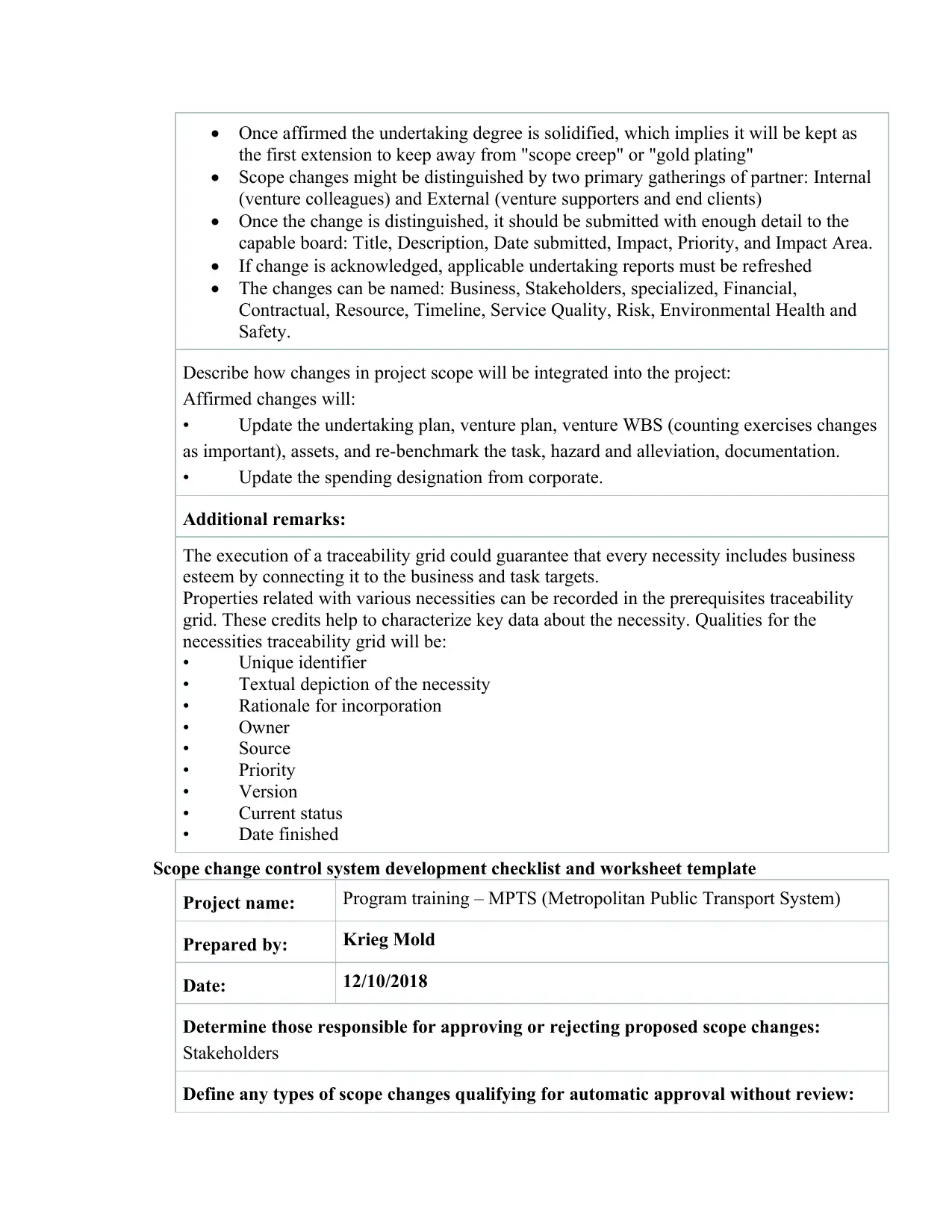
Once affirmed the undertaking degree is solidified, which implies it will be kept as
the first extension to keep away from "scope creep" or "gold plating"
Scope changes might be distinguished by two primary gatherings of partner: Internal
(venture colleagues) and External (venture supporters and end clients)
Once the change is distinguished, it should be submitted with enough detail to the
capable board: Title, Description, Date submitted, Impact, Priority, and Impact Area.
If change is acknowledged, applicable undertaking reports must be refreshed
The changes can be named: Business, Stakeholders, specialized, Financial,
Contractual, Resource, Timeline, Service Quality, Risk, Environmental Health and
Safety.
Describe how changes in project scope will be integrated into the project:
Affirmed changes will:
• Update the undertaking plan, venture plan, venture WBS (counting exercises changes
as important), assets, and re-benchmark the task, hazard and alleviation, documentation.
• Update the spending designation from corporate.
Additional remarks:
The execution of a traceability grid could guarantee that every necessity includes business
esteem by connecting it to the business and task targets.
Properties related with various necessities can be recorded in the prerequisites traceability
grid. These credits help to characterize key data about the necessity. Qualities for the
necessities traceability grid will be:
• Unique identifier
• Textual depiction of the necessity
• Rationale for incorporation
• Owner
• Source
• Priority
• Version
• Current status
• Date finished
Scope change control system development checklist and worksheet template
Project name: Program training – MPTS (Metropolitan Public Transport System)
Prepared by: Krieg Mold
Date: 12/10/2018
Determine those responsible for approving or rejecting proposed scope changes:
Stakeholders
Define any types of scope changes qualifying for automatic approval without review:
the first extension to keep away from "scope creep" or "gold plating"
Scope changes might be distinguished by two primary gatherings of partner: Internal
(venture colleagues) and External (venture supporters and end clients)
Once the change is distinguished, it should be submitted with enough detail to the
capable board: Title, Description, Date submitted, Impact, Priority, and Impact Area.
If change is acknowledged, applicable undertaking reports must be refreshed
The changes can be named: Business, Stakeholders, specialized, Financial,
Contractual, Resource, Timeline, Service Quality, Risk, Environmental Health and
Safety.
Describe how changes in project scope will be integrated into the project:
Affirmed changes will:
• Update the undertaking plan, venture plan, venture WBS (counting exercises changes
as important), assets, and re-benchmark the task, hazard and alleviation, documentation.
• Update the spending designation from corporate.
Additional remarks:
The execution of a traceability grid could guarantee that every necessity includes business
esteem by connecting it to the business and task targets.
Properties related with various necessities can be recorded in the prerequisites traceability
grid. These credits help to characterize key data about the necessity. Qualities for the
necessities traceability grid will be:
• Unique identifier
• Textual depiction of the necessity
• Rationale for incorporation
• Owner
• Source
• Priority
• Version
• Current status
• Date finished
Scope change control system development checklist and worksheet template
Project name: Program training – MPTS (Metropolitan Public Transport System)
Prepared by: Krieg Mold
Date: 12/10/2018
Determine those responsible for approving or rejecting proposed scope changes:
Stakeholders
Define any types of scope changes qualifying for automatic approval without review:
Paraphrase This Document
Need a fresh take? Get an instant paraphrase of this document with our AI Paraphraser
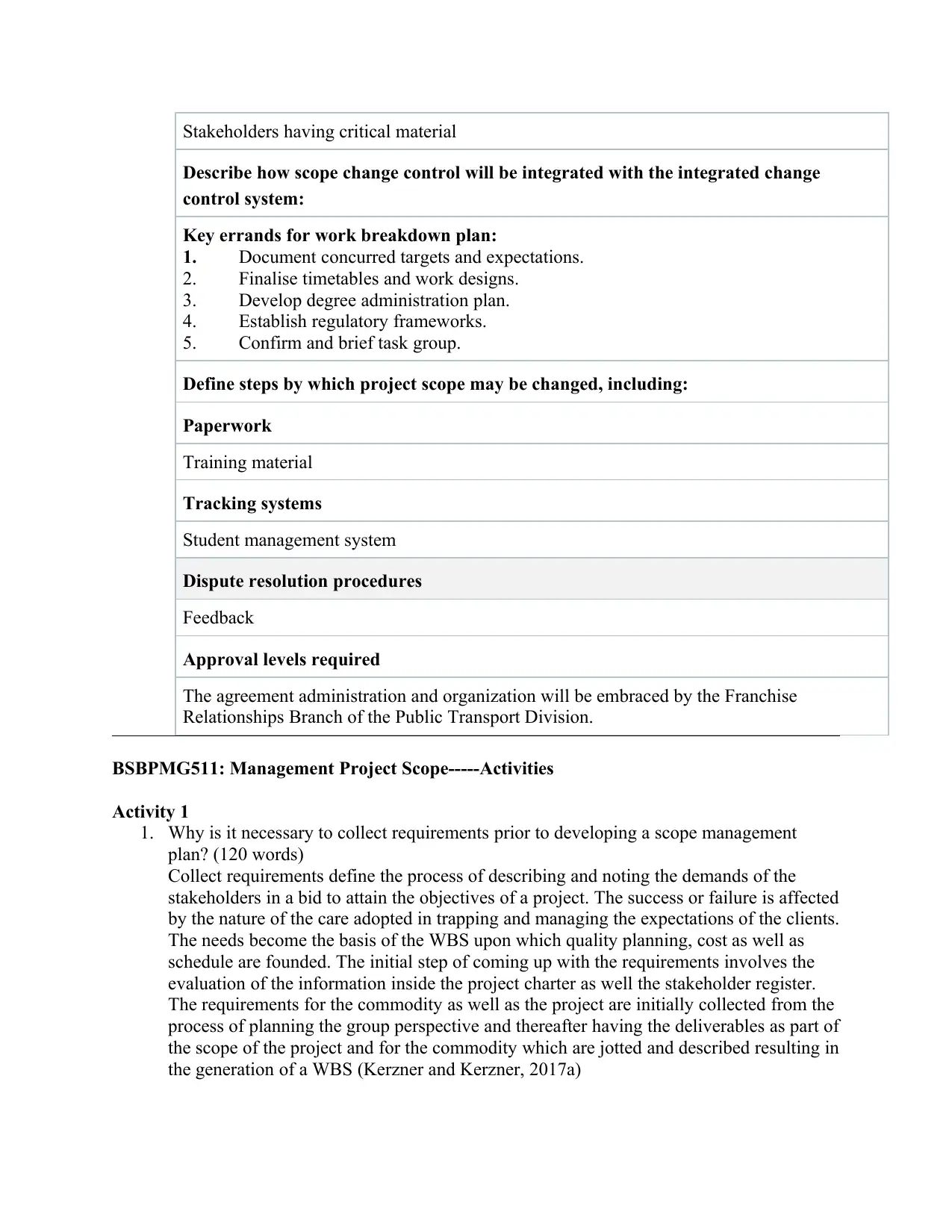
Stakeholders having critical material
Describe how scope change control will be integrated with the integrated change
control system:
Key errands for work breakdown plan:
1. Document concurred targets and expectations.
2. Finalise timetables and work designs.
3. Develop degree administration plan.
4. Establish regulatory frameworks.
5. Confirm and brief task group.
Define steps by which project scope may be changed, including:
Paperwork
Training material
Tracking systems
Student management system
Dispute resolution procedures
Feedback
Approval levels required
The agreement administration and organization will be embraced by the Franchise
Relationships Branch of the Public Transport Division.
BSBPMG511: Management Project Scope-----Activities
Activity 1
1. Why is it necessary to collect requirements prior to developing a scope management
plan? (120 words)
Collect requirements define the process of describing and noting the demands of the
stakeholders in a bid to attain the objectives of a project. The success or failure is affected
by the nature of the care adopted in trapping and managing the expectations of the clients.
The needs become the basis of the WBS upon which quality planning, cost as well as
schedule are founded. The initial step of coming up with the requirements involves the
evaluation of the information inside the project charter as well the stakeholder register.
The requirements for the commodity as well as the project are initially collected from the
process of planning the group perspective and thereafter having the deliverables as part of
the scope of the project and for the commodity which are jotted and described resulting in
the generation of a WBS (Kerzner and Kerzner, 2017a)
Describe how scope change control will be integrated with the integrated change
control system:
Key errands for work breakdown plan:
1. Document concurred targets and expectations.
2. Finalise timetables and work designs.
3. Develop degree administration plan.
4. Establish regulatory frameworks.
5. Confirm and brief task group.
Define steps by which project scope may be changed, including:
Paperwork
Training material
Tracking systems
Student management system
Dispute resolution procedures
Feedback
Approval levels required
The agreement administration and organization will be embraced by the Franchise
Relationships Branch of the Public Transport Division.
BSBPMG511: Management Project Scope-----Activities
Activity 1
1. Why is it necessary to collect requirements prior to developing a scope management
plan? (120 words)
Collect requirements define the process of describing and noting the demands of the
stakeholders in a bid to attain the objectives of a project. The success or failure is affected
by the nature of the care adopted in trapping and managing the expectations of the clients.
The needs become the basis of the WBS upon which quality planning, cost as well as
schedule are founded. The initial step of coming up with the requirements involves the
evaluation of the information inside the project charter as well the stakeholder register.
The requirements for the commodity as well as the project are initially collected from the
process of planning the group perspective and thereafter having the deliverables as part of
the scope of the project and for the commodity which are jotted and described resulting in
the generation of a WBS (Kerzner and Kerzner, 2017a)
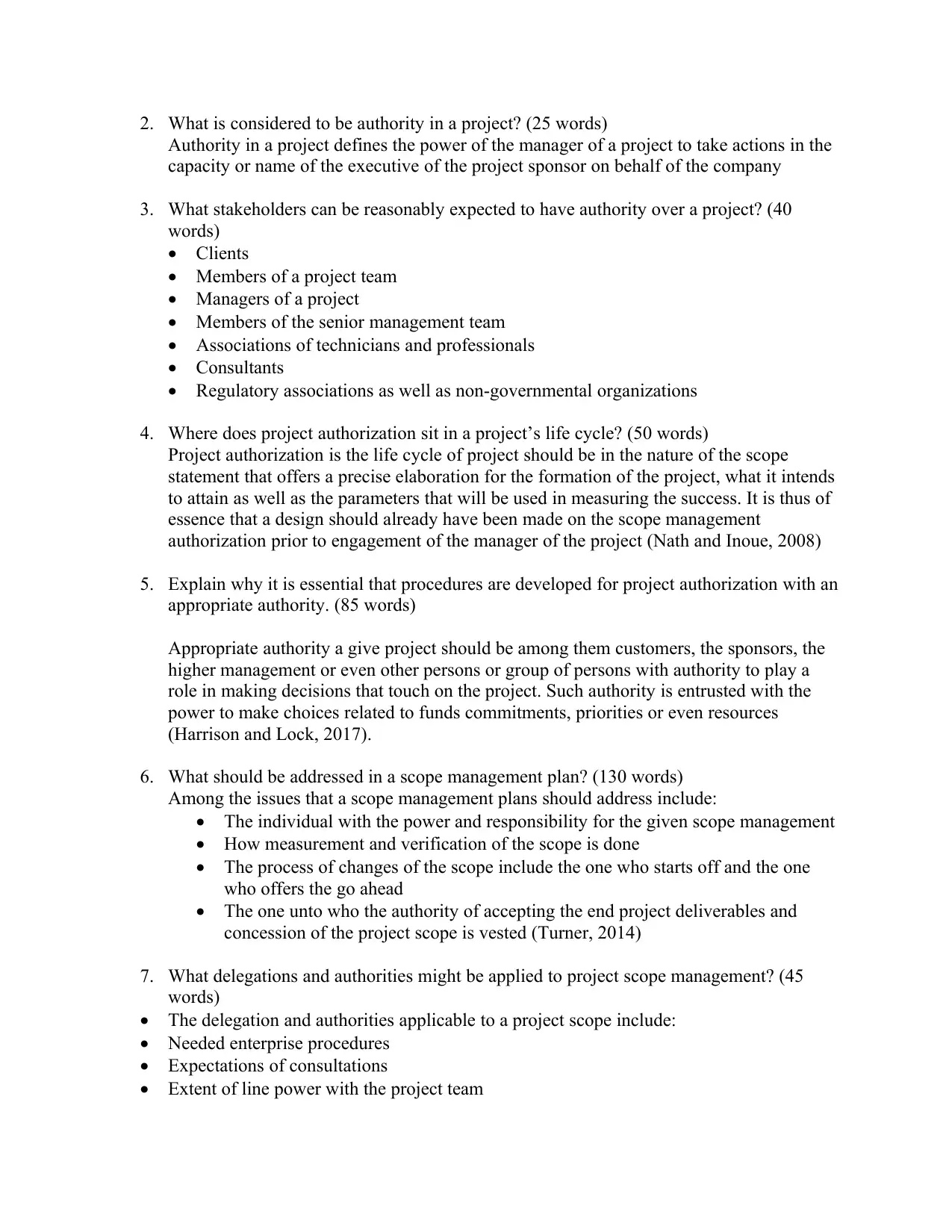
2. What is considered to be authority in a project? (25 words)
Authority in a project defines the power of the manager of a project to take actions in the
capacity or name of the executive of the project sponsor on behalf of the company
3. What stakeholders can be reasonably expected to have authority over a project? (40
words)
Clients
Members of a project team
Managers of a project
Members of the senior management team
Associations of technicians and professionals
Consultants
Regulatory associations as well as non-governmental organizations
4. Where does project authorization sit in a project’s life cycle? (50 words)
Project authorization is the life cycle of project should be in the nature of the scope
statement that offers a precise elaboration for the formation of the project, what it intends
to attain as well as the parameters that will be used in measuring the success. It is thus of
essence that a design should already have been made on the scope management
authorization prior to engagement of the manager of the project (Nath and Inoue, 2008)
5. Explain why it is essential that procedures are developed for project authorization with an
appropriate authority. (85 words)
Appropriate authority a give project should be among them customers, the sponsors, the
higher management or even other persons or group of persons with authority to play a
role in making decisions that touch on the project. Such authority is entrusted with the
power to make choices related to funds commitments, priorities or even resources
(Harrison and Lock, 2017).
6. What should be addressed in a scope management plan? (130 words)
Among the issues that a scope management plans should address include:
The individual with the power and responsibility for the given scope management
How measurement and verification of the scope is done
The process of changes of the scope include the one who starts off and the one
who offers the go ahead
The one unto who the authority of accepting the end project deliverables and
concession of the project scope is vested (Turner, 2014)
7. What delegations and authorities might be applied to project scope management? (45
words)
The delegation and authorities applicable to a project scope include:
Needed enterprise procedures
Expectations of consultations
Extent of line power with the project team
Authority in a project defines the power of the manager of a project to take actions in the
capacity or name of the executive of the project sponsor on behalf of the company
3. What stakeholders can be reasonably expected to have authority over a project? (40
words)
Clients
Members of a project team
Managers of a project
Members of the senior management team
Associations of technicians and professionals
Consultants
Regulatory associations as well as non-governmental organizations
4. Where does project authorization sit in a project’s life cycle? (50 words)
Project authorization is the life cycle of project should be in the nature of the scope
statement that offers a precise elaboration for the formation of the project, what it intends
to attain as well as the parameters that will be used in measuring the success. It is thus of
essence that a design should already have been made on the scope management
authorization prior to engagement of the manager of the project (Nath and Inoue, 2008)
5. Explain why it is essential that procedures are developed for project authorization with an
appropriate authority. (85 words)
Appropriate authority a give project should be among them customers, the sponsors, the
higher management or even other persons or group of persons with authority to play a
role in making decisions that touch on the project. Such authority is entrusted with the
power to make choices related to funds commitments, priorities or even resources
(Harrison and Lock, 2017).
6. What should be addressed in a scope management plan? (130 words)
Among the issues that a scope management plans should address include:
The individual with the power and responsibility for the given scope management
How measurement and verification of the scope is done
The process of changes of the scope include the one who starts off and the one
who offers the go ahead
The one unto who the authority of accepting the end project deliverables and
concession of the project scope is vested (Turner, 2014)
7. What delegations and authorities might be applied to project scope management? (45
words)
The delegation and authorities applicable to a project scope include:
Needed enterprise procedures
Expectations of consultations
Extent of line power with the project team
⊘ This is a preview!⊘
Do you want full access?
Subscribe today to unlock all pages.

Trusted by 1+ million students worldwide
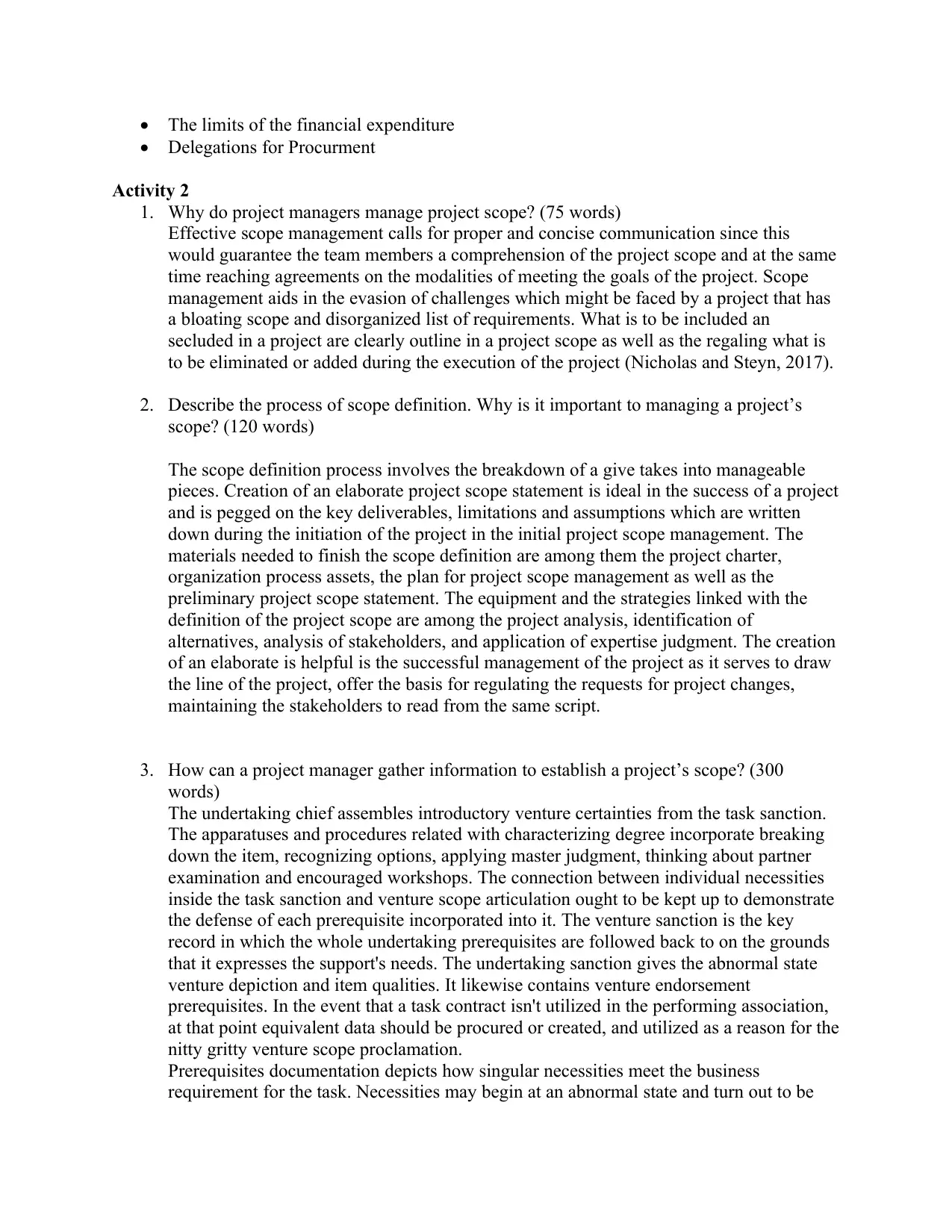
The limits of the financial expenditure
Delegations for Procurment
Activity 2
1. Why do project managers manage project scope? (75 words)
Effective scope management calls for proper and concise communication since this
would guarantee the team members a comprehension of the project scope and at the same
time reaching agreements on the modalities of meeting the goals of the project. Scope
management aids in the evasion of challenges which might be faced by a project that has
a bloating scope and disorganized list of requirements. What is to be included an
secluded in a project are clearly outline in a project scope as well as the regaling what is
to be eliminated or added during the execution of the project (Nicholas and Steyn, 2017).
2. Describe the process of scope definition. Why is it important to managing a project’s
scope? (120 words)
The scope definition process involves the breakdown of a give takes into manageable
pieces. Creation of an elaborate project scope statement is ideal in the success of a project
and is pegged on the key deliverables, limitations and assumptions which are written
down during the initiation of the project in the initial project scope management. The
materials needed to finish the scope definition are among them the project charter,
organization process assets, the plan for project scope management as well as the
preliminary project scope statement. The equipment and the strategies linked with the
definition of the project scope are among the project analysis, identification of
alternatives, analysis of stakeholders, and application of expertise judgment. The creation
of an elaborate is helpful is the successful management of the project as it serves to draw
the line of the project, offer the basis for regulating the requests for project changes,
maintaining the stakeholders to read from the same script.
3. How can a project manager gather information to establish a project’s scope? (300
words)
The undertaking chief assembles introductory venture certainties from the task sanction.
The apparatuses and procedures related with characterizing degree incorporate breaking
down the item, recognizing options, applying master judgment, thinking about partner
examination and encouraged workshops. The connection between individual necessities
inside the task sanction and venture scope articulation ought to be kept up to demonstrate
the defense of each prerequisite incorporated into it. The venture sanction is the key
record in which the whole undertaking prerequisites are followed back to on the grounds
that it expresses the support's needs. The undertaking sanction gives the abnormal state
venture depiction and item qualities. It likewise contains venture endorsement
prerequisites. In the event that a task contract isn't utilized in the performing association,
at that point equivalent data should be procured or created, and utilized as a reason for the
nitty gritty venture scope proclamation.
Prerequisites documentation depicts how singular necessities meet the business
requirement for the task. Necessities may begin at an abnormal state and turn out to be
Delegations for Procurment
Activity 2
1. Why do project managers manage project scope? (75 words)
Effective scope management calls for proper and concise communication since this
would guarantee the team members a comprehension of the project scope and at the same
time reaching agreements on the modalities of meeting the goals of the project. Scope
management aids in the evasion of challenges which might be faced by a project that has
a bloating scope and disorganized list of requirements. What is to be included an
secluded in a project are clearly outline in a project scope as well as the regaling what is
to be eliminated or added during the execution of the project (Nicholas and Steyn, 2017).
2. Describe the process of scope definition. Why is it important to managing a project’s
scope? (120 words)
The scope definition process involves the breakdown of a give takes into manageable
pieces. Creation of an elaborate project scope statement is ideal in the success of a project
and is pegged on the key deliverables, limitations and assumptions which are written
down during the initiation of the project in the initial project scope management. The
materials needed to finish the scope definition are among them the project charter,
organization process assets, the plan for project scope management as well as the
preliminary project scope statement. The equipment and the strategies linked with the
definition of the project scope are among the project analysis, identification of
alternatives, analysis of stakeholders, and application of expertise judgment. The creation
of an elaborate is helpful is the successful management of the project as it serves to draw
the line of the project, offer the basis for regulating the requests for project changes,
maintaining the stakeholders to read from the same script.
3. How can a project manager gather information to establish a project’s scope? (300
words)
The undertaking chief assembles introductory venture certainties from the task sanction.
The apparatuses and procedures related with characterizing degree incorporate breaking
down the item, recognizing options, applying master judgment, thinking about partner
examination and encouraged workshops. The connection between individual necessities
inside the task sanction and venture scope articulation ought to be kept up to demonstrate
the defense of each prerequisite incorporated into it. The venture sanction is the key
record in which the whole undertaking prerequisites are followed back to on the grounds
that it expresses the support's needs. The undertaking sanction gives the abnormal state
venture depiction and item qualities. It likewise contains venture endorsement
prerequisites. In the event that a task contract isn't utilized in the performing association,
at that point equivalent data should be procured or created, and utilized as a reason for the
nitty gritty venture scope proclamation.
Prerequisites documentation depicts how singular necessities meet the business
requirement for the task. Necessities may begin at an abnormal state and turn out to be
Paraphrase This Document
Need a fresh take? Get an instant paraphrase of this document with our AI Paraphraser
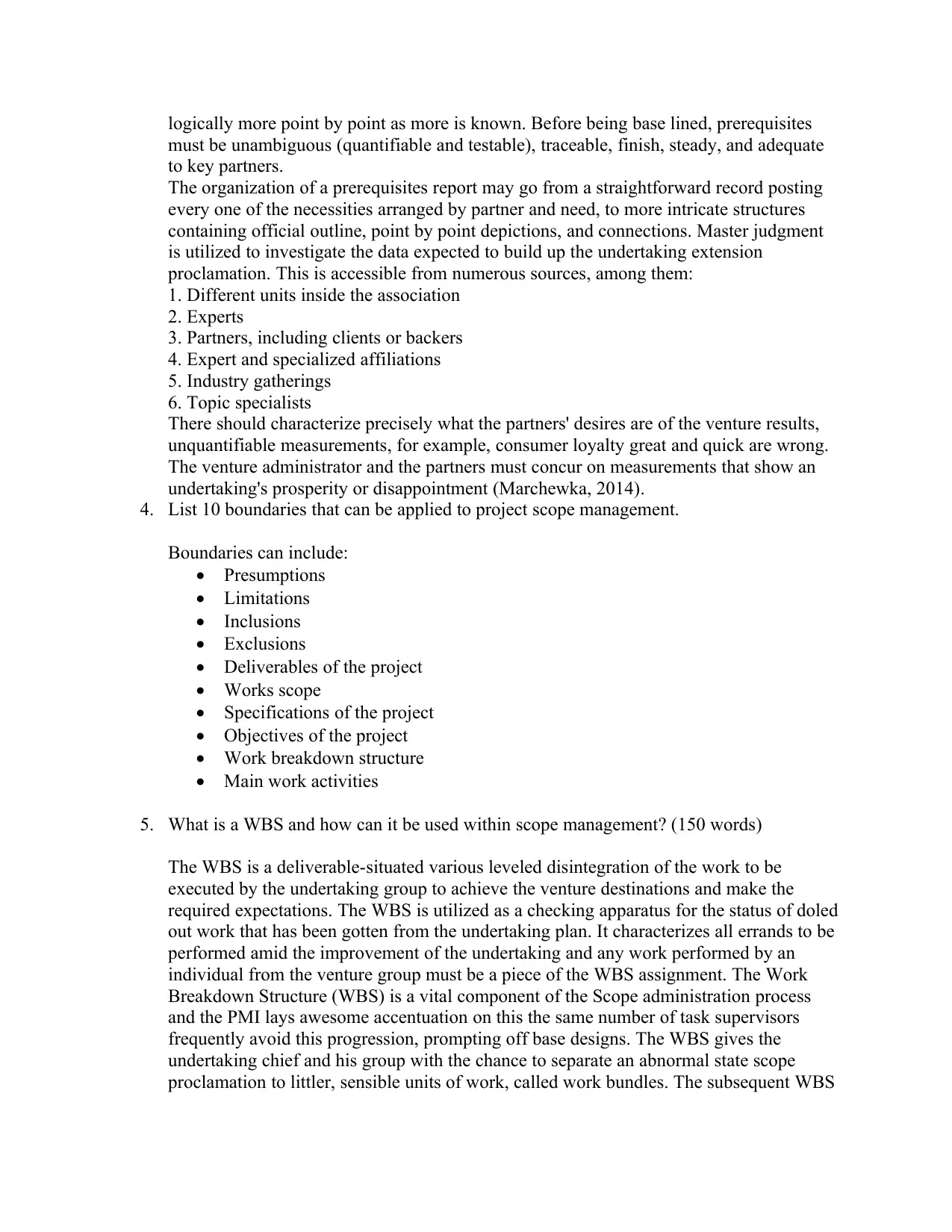
logically more point by point as more is known. Before being base lined, prerequisites
must be unambiguous (quantifiable and testable), traceable, finish, steady, and adequate
to key partners.
The organization of a prerequisites report may go from a straightforward record posting
every one of the necessities arranged by partner and need, to more intricate structures
containing official outline, point by point depictions, and connections. Master judgment
is utilized to investigate the data expected to build up the undertaking extension
proclamation. This is accessible from numerous sources, among them:
1. Different units inside the association
2. Experts
3. Partners, including clients or backers
4. Expert and specialized affiliations
5. Industry gatherings
6. Topic specialists
There should characterize precisely what the partners' desires are of the venture results,
unquantifiable measurements, for example, consumer loyalty great and quick are wrong.
The venture administrator and the partners must concur on measurements that show an
undertaking's prosperity or disappointment (Marchewka, 2014).
4. List 10 boundaries that can be applied to project scope management.
Boundaries can include:
Presumptions
Limitations
Inclusions
Exclusions
Deliverables of the project
Works scope
Specifications of the project
Objectives of the project
Work breakdown structure
Main work activities
5. What is a WBS and how can it be used within scope management? (150 words)
The WBS is a deliverable-situated various leveled disintegration of the work to be
executed by the undertaking group to achieve the venture destinations and make the
required expectations. The WBS is utilized as a checking apparatus for the status of doled
out work that has been gotten from the undertaking plan. It characterizes all errands to be
performed amid the improvement of the undertaking and any work performed by an
individual from the venture group must be a piece of the WBS assignment. The Work
Breakdown Structure (WBS) is a vital component of the Scope administration process
and the PMI lays awesome accentuation on this the same number of task supervisors
frequently avoid this progression, prompting off base designs. The WBS gives the
undertaking chief and his group with the chance to separate an abnormal state scope
proclamation to littler, sensible units of work, called work bundles. The subsequent WBS
must be unambiguous (quantifiable and testable), traceable, finish, steady, and adequate
to key partners.
The organization of a prerequisites report may go from a straightforward record posting
every one of the necessities arranged by partner and need, to more intricate structures
containing official outline, point by point depictions, and connections. Master judgment
is utilized to investigate the data expected to build up the undertaking extension
proclamation. This is accessible from numerous sources, among them:
1. Different units inside the association
2. Experts
3. Partners, including clients or backers
4. Expert and specialized affiliations
5. Industry gatherings
6. Topic specialists
There should characterize precisely what the partners' desires are of the venture results,
unquantifiable measurements, for example, consumer loyalty great and quick are wrong.
The venture administrator and the partners must concur on measurements that show an
undertaking's prosperity or disappointment (Marchewka, 2014).
4. List 10 boundaries that can be applied to project scope management.
Boundaries can include:
Presumptions
Limitations
Inclusions
Exclusions
Deliverables of the project
Works scope
Specifications of the project
Objectives of the project
Work breakdown structure
Main work activities
5. What is a WBS and how can it be used within scope management? (150 words)
The WBS is a deliverable-situated various leveled disintegration of the work to be
executed by the undertaking group to achieve the venture destinations and make the
required expectations. The WBS is utilized as a checking apparatus for the status of doled
out work that has been gotten from the undertaking plan. It characterizes all errands to be
performed amid the improvement of the undertaking and any work performed by an
individual from the venture group must be a piece of the WBS assignment. The Work
Breakdown Structure (WBS) is a vital component of the Scope administration process
and the PMI lays awesome accentuation on this the same number of task supervisors
frequently avoid this progression, prompting off base designs. The WBS gives the
undertaking chief and his group with the chance to separate an abnormal state scope
proclamation to littler, sensible units of work, called work bundles. The subsequent WBS
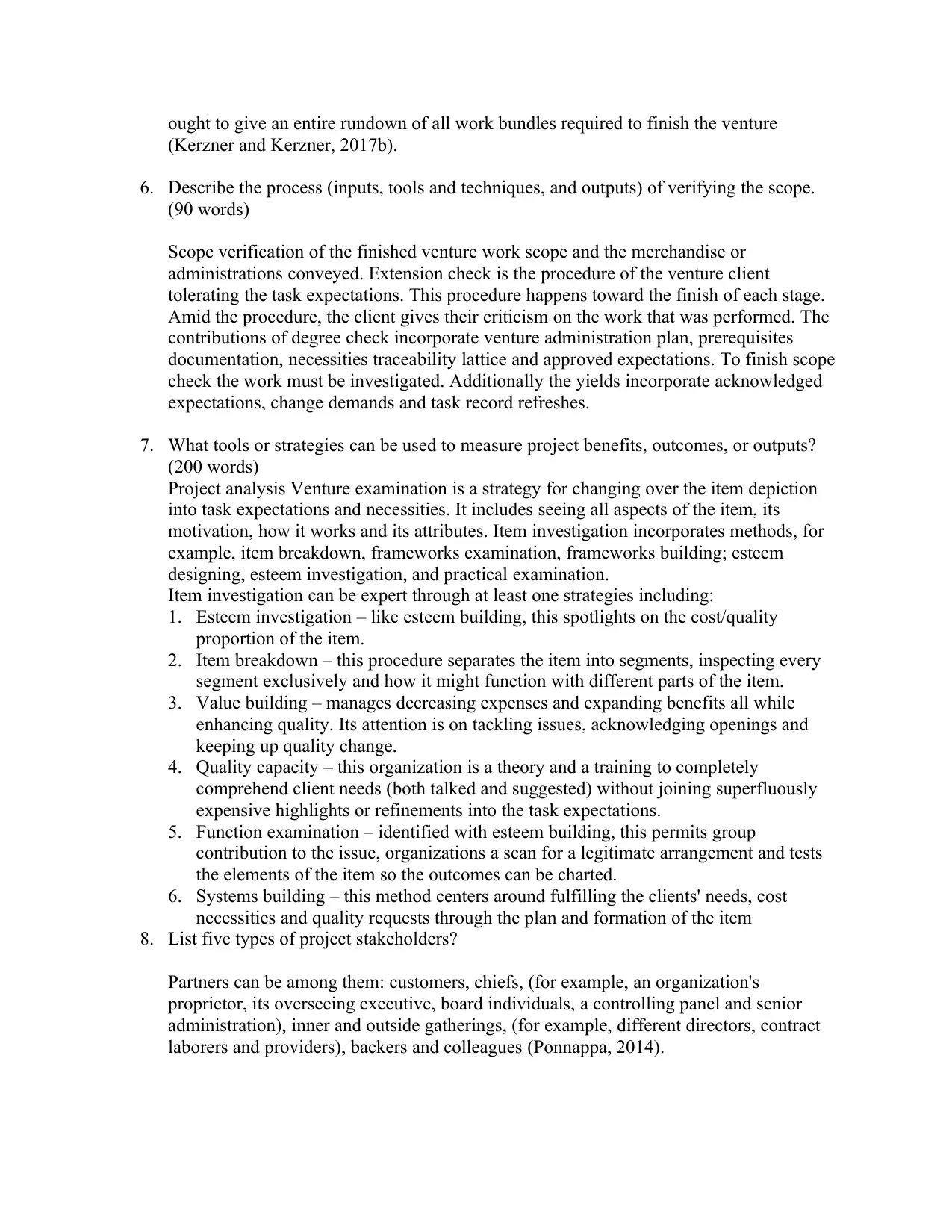
ought to give an entire rundown of all work bundles required to finish the venture
(Kerzner and Kerzner, 2017b).
6. Describe the process (inputs, tools and techniques, and outputs) of verifying the scope.
(90 words)
Scope verification of the finished venture work scope and the merchandise or
administrations conveyed. Extension check is the procedure of the venture client
tolerating the task expectations. This procedure happens toward the finish of each stage.
Amid the procedure, the client gives their criticism on the work that was performed. The
contributions of degree check incorporate venture administration plan, prerequisites
documentation, necessities traceability lattice and approved expectations. To finish scope
check the work must be investigated. Additionally the yields incorporate acknowledged
expectations, change demands and task record refreshes.
7. What tools or strategies can be used to measure project benefits, outcomes, or outputs?
(200 words)
Project analysis Venture examination is a strategy for changing over the item depiction
into task expectations and necessities. It includes seeing all aspects of the item, its
motivation, how it works and its attributes. Item investigation incorporates methods, for
example, item breakdown, frameworks examination, frameworks building; esteem
designing, esteem investigation, and practical examination.
Item investigation can be expert through at least one strategies including:
1. Esteem investigation – like esteem building, this spotlights on the cost/quality
proportion of the item.
2. Item breakdown – this procedure separates the item into segments, inspecting every
segment exclusively and how it might function with different parts of the item.
3. Value building – manages decreasing expenses and expanding benefits all while
enhancing quality. Its attention is on tackling issues, acknowledging openings and
keeping up quality change.
4. Quality capacity – this organization is a theory and a training to completely
comprehend client needs (both talked and suggested) without joining superfluously
expensive highlights or refinements into the task expectations.
5. Function examination – identified with esteem building, this permits group
contribution to the issue, organizations a scan for a legitimate arrangement and tests
the elements of the item so the outcomes can be charted.
6. Systems building – this method centers around fulfilling the clients' needs, cost
necessities and quality requests through the plan and formation of the item
8. List five types of project stakeholders?
Partners can be among them: customers, chiefs, (for example, an organization's
proprietor, its overseeing executive, board individuals, a controlling panel and senior
administration), inner and outside gatherings, (for example, different directors, contract
laborers and providers), backers and colleagues (Ponnappa, 2014).
(Kerzner and Kerzner, 2017b).
6. Describe the process (inputs, tools and techniques, and outputs) of verifying the scope.
(90 words)
Scope verification of the finished venture work scope and the merchandise or
administrations conveyed. Extension check is the procedure of the venture client
tolerating the task expectations. This procedure happens toward the finish of each stage.
Amid the procedure, the client gives their criticism on the work that was performed. The
contributions of degree check incorporate venture administration plan, prerequisites
documentation, necessities traceability lattice and approved expectations. To finish scope
check the work must be investigated. Additionally the yields incorporate acknowledged
expectations, change demands and task record refreshes.
7. What tools or strategies can be used to measure project benefits, outcomes, or outputs?
(200 words)
Project analysis Venture examination is a strategy for changing over the item depiction
into task expectations and necessities. It includes seeing all aspects of the item, its
motivation, how it works and its attributes. Item investigation incorporates methods, for
example, item breakdown, frameworks examination, frameworks building; esteem
designing, esteem investigation, and practical examination.
Item investigation can be expert through at least one strategies including:
1. Esteem investigation – like esteem building, this spotlights on the cost/quality
proportion of the item.
2. Item breakdown – this procedure separates the item into segments, inspecting every
segment exclusively and how it might function with different parts of the item.
3. Value building – manages decreasing expenses and expanding benefits all while
enhancing quality. Its attention is on tackling issues, acknowledging openings and
keeping up quality change.
4. Quality capacity – this organization is a theory and a training to completely
comprehend client needs (both talked and suggested) without joining superfluously
expensive highlights or refinements into the task expectations.
5. Function examination – identified with esteem building, this permits group
contribution to the issue, organizations a scan for a legitimate arrangement and tests
the elements of the item so the outcomes can be charted.
6. Systems building – this method centers around fulfilling the clients' needs, cost
necessities and quality requests through the plan and formation of the item
8. List five types of project stakeholders?
Partners can be among them: customers, chiefs, (for example, an organization's
proprietor, its overseeing executive, board individuals, a controlling panel and senior
administration), inner and outside gatherings, (for example, different directors, contract
laborers and providers), backers and colleagues (Ponnappa, 2014).
⊘ This is a preview!⊘
Do you want full access?
Subscribe today to unlock all pages.

Trusted by 1+ million students worldwide
1 out of 41
Your All-in-One AI-Powered Toolkit for Academic Success.
+13062052269
info@desklib.com
Available 24*7 on WhatsApp / Email
![[object Object]](/_next/static/media/star-bottom.7253800d.svg)
Unlock your academic potential
Copyright © 2020–2025 A2Z Services. All Rights Reserved. Developed and managed by ZUCOL.


